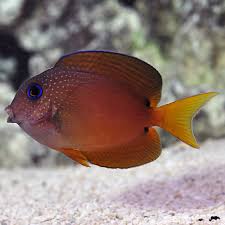Blue Eye Kole Tang
Blue Eye Kole Tang
check_circle Fast Shipping
check_circle Quality Products
check_circle Affordable Price
Reach out to us on ''available to order'' items via WhatsApp or email
Low stock: 1 left
Couldn't load pickup availability

Blue Eye Kole Tang
package_2
Product Description
Product Description
The Blue Eye Kole (Ctenochaetus binotatus), also known as the Blue-eyed Tang, is a beautiful and peaceful species of surgeonfish that is popular in marine aquariums. Here’s some information on their care and description:
Description
-
Size: Blue Eye Kole tangs typically grow to about 6 to 8 inches (15 to 20 cm).
-
Appearance: They have a unique body shape typical of tangs, with a slightly oval, compressed body. Their coloration is a mix of brownish-yellow with bright blue markings around the eyes, which gives them the name "Blue Eye Kole." They also have sharp spines on each side of their tail.
-
Behavior: These fish are active swimmers and enjoy having ample space to move. They are generally peaceful and can be kept in community tanks with other non-aggressive species. They do, however, defend their territory, particularly during feeding times.
Care Requirements
-
Tank Size:
-
A minimum of 70 gallons (265 liters) is recommended for one Blue Eye Kole, although larger is always better. They require plenty of swimming space to stay healthy.
-
-
Water Conditions:
-
Temperature: 72–78°F (22–26°C)
-
pH: 8.1–8.4
-
Salinity: 1.023–1.025 specific gravity
-
Ammonia/Nitrite: 0 ppm (parts per million)
-
Nitrate: <10 ppm
It is crucial to keep the water quality stable and ensure good filtration since tangs are sensitive to changes in water parameters.
-
-
Diet:
-
Blue Eye Kole tangs are primarily herbivorous and should be fed a diet rich in algae, which they graze on in the wild. You can offer:
-
Nori (seaweed): A staple in their diet. It can be fed on clips or left floating in the tank.
-
Spirulina: A type of algae supplement available in flake or pellet form.
-
Vegetable matter: Blanched vegetables like zucchini, spinach, and lettuce.
-
Occasional meaty foods: Though primarily herbivores, offering some meaty food like shrimp or fish occasionally can supplement their diet.
-
-
-
Tank Mates:
-
They are generally peaceful but can become territorial, especially if other tangs or surgeonfish are in the same tank. It’s best to avoid keeping them with overly aggressive fish or similar-looking species.
-
Suitable tank mates include peaceful fish such as clownfish, wrasses, and gobies.
-
Avoid keeping multiple tangs of the same genus together.
-
-
Habitat:
-
The Blue Eye Kole prefers a well-established tank with plenty of live rock, which provides both hiding spots and surfaces to graze on.
-
They are often found in the wild in coral reefs where they graze on algae, so replicate that environment by ensuring that your tank has plenty of rocks and some algae growth.
-
-
Behavioral Notes:
-
These fish are usually active and enjoy grazing on algae. They are often seen swimming in small groups in the wild.
-
They can be shy at first but often become more confident in a stable, well-established tank.
-
Common Issues:
-
Ich (Marine White Spot Disease): Like many tangs, the Blue Eye Kole is prone to this parasite. Quarantining new fish and maintaining good water quality can help prevent outbreaks.
-
Stress: This species can become stressed if water conditions are not optimal, or if they are kept in too small a tank or with aggressive tank mates.
Final Thoughts:
The Blue Eye Kole is a beautiful and rewarding fish to keep in a marine tank. With the right water conditions, diet, and tank mates, it can thrive and add a touch of elegance to your aquarium. Just remember that they are best suited for more experienced aquarists due to their specific care requirements


